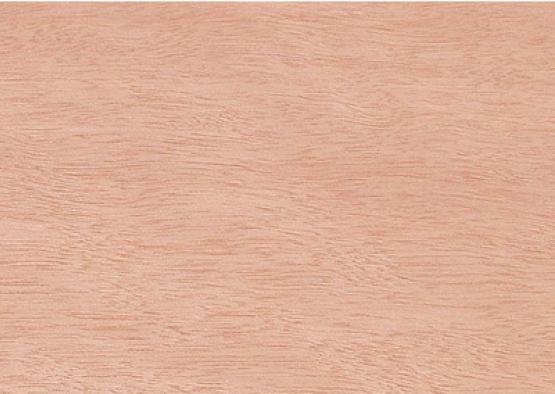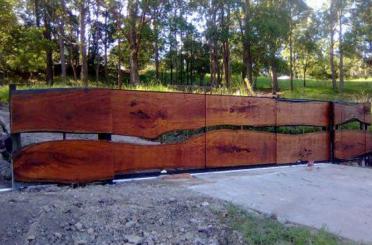Broad-leaved tea tree is a moderately durable timber commonly used in general construction and for fence posts, railway sleepers and mine props.
Brown Tea-tree, Paperbark, Cajuput Tree, Weeping Tea Tree, Weeping Paperbark, Broad-leaved Paperbark, Melaleuca quinquenervia, Melaleuca viridiflora
Melaleuca leucadendron

Few species of so-called 'paperbarks' - the larger members of the genus Melaleuca - have commercial uses apart from in the production of honey and essential oils. The timber of Melaleuca leucadendron, however - known to have been used by Indigenous Australians in the manufacture of dugout canoes - has a history of use in a variety of commercial applications including railway sleepers, fence posts and mine props.
Broad-leaved tea tree is widely used in general construction, for flooring, boat knees (cut from the natural shapes of tree branches) and oyster rack structural members (with bark intact). The bark is used for lining fernery baskets and for making bark paintings. The cork from the bark is used for infants' pillows and mattresses. Small stems of tea tree with bark intact make an attractive fencing material.
The heartwood of this species is pinkish-brown in colour. Sapwood is distinctively paler. Grain is often interlocked and the timber exhibits a fine and even texture.
Broad-leaved tea tree occurs in northern New South Wales, Queensland, the Northern Territory and Western Australia. Small quantities are occasionally imported from Papua New Guinea, Indonesia and Malaysia.
Shrinkage
| Very Low | Low | Medium | High | Very High | |
|---|---|---|---|---|---|

|

|

|
|||
Tangential : |
4.50%
|
||||
Radial : |
3.30%
|
||||
Unit Movement Tangential: |
0.27%
|
||||
Unit Movement Radial: |
0.26%
|
Strength Group

Very High |
High |
Reasonably High |
Medium High |
Medium |
Reasonably Low |
Low |
Very Low |
||
Unseasoned: |
S1 |
S2 |
S3 |
S4 |
S5 |
S6 |
S7 |
S8 |
|
|---|---|---|---|---|---|---|---|---|---|
 |
|||||||||
Seasoned: |
SD1 |
SD2 |
SD3 |
SD4 |
SD5 |
SD6 |
SD7 |
SD8 |
|
 |
Stress Grade

| Structural No. 1 |
Structural No. 2 |
Structural No. 3 |
Structural No. 4 |
Structural No. 5 |
|
Unseasoned: |
F14 |
F11 |
F8 |
F7 |
F5 |
Seasoned: |
F22 |
F17 |
F14 |
F11 |
F8 |
Density per Standard

Seasoned: |
745kg/m3
|
|---|---|
Unseasoned: |
Joint Group

Very High |
High |
Reasonably High |
Medium |
Low |
Very Low |
|
Unseasoned: |
J1 |
J2 |
J3 |
J4 |
J5 |
J6 |
|---|---|---|---|---|---|---|
 |
||||||
Seasoned: |
JD1 |
JD2 |
JD3 |
JD4 |
JD5 |
JD6 |
 |
Colour

| White, yellow, pale straw to light brown | Pink to pink brown | Light to dark red | Brown, chocolate, mottled or streaky | |
 |
||||
Mechanical Properties
Modulus of Rupture - Unseasoned: |
82
|
|---|---|
Modulus of Rupture - Seasoned: |
97
|
Modulus of Elasticity - Unseasoned: |
9.2
|
Modulus of Elasticity - Seasoned: |
13
|
Maximum Crushing Strength - Unseasoned:  |
41
|
Maximum Crushing Strength - Seasoned: |
53
|
Impact - Unseasoned: |
14
|
Impact - Seasoned: |
11
|
Toughness - Unseasoned: |
|
Toughness - Seasoned: |
|
Hardness - Unseasoned: |
6.8
|
Hardness - Seasoned: |
7.3
|
Durability
| Low | Moderate | Reasonably High | High | |
| (0 - 5 yrs) | (5 - 15 yrs) | (15 - 25 yrs) | (more than 25 yrs) | |
In-Ground: |
 |
|||
| (0 - 7 yrs) | (7 - 15 yrs) | (15 - 40 yrs) | (More than 40 yrs) | |
Above ground: |
 |
|||
| (0 - 20 yrs, usually < 5) | (21 - 40 yrs) | (41 - 64 yrs) | (More than 60 yrs) | |
Marine Borer Resistance: |
 |
Lyctid Borer Susceptibility: |
Susceptible |
|---|---|
Lyctid Borer Susceptibility - Other: |
|
Termite Resistance: |
Fire Properties
| 1 - non-combustible | 2 - reasonably non-combustible | 3 - slightly combustible | 4 - combustible | |
Fire Properties Group |
Group Number - Other: |
3 if used on MDF or particleboard ≥12mm; veneer thickness 0.6-0.85mm
|
|---|---|
Average Specific Extinction Area: |
<250
|
Bushfire Resistance: |
BAL 12.5 and 19 – All AS3959 required applications
|
The heartwood of this hardwood species is pinkish brown in colour. Sapwood is usually distinctively paler. Grain is often interlocked, with a fine and even texture.
Originally used by Indigenous Australians in the manufacture of dugout canoes, the timber of this species has a history of use for a variety of commercial applications including railway sleepers, fence posts and mine props.
Common applications include general construction, flooring, boat knees (cut from the natural shapes of tree branches), and oyster rack structural members (with bark intact). The bark is used for lining fernery baskets and for making bark paintings consisting of a collage of pieces of differing colour and shape. The cork from the bark can be used for infants' pillows and mattresses, having the advantage of easy washing and sterilisation while at the same time being open enough to allow ready access of air, virtually avoiding the risk of accidental suffocation. Small stems of broad-leaved tea tree with bark intact make an attractive fencing material.
Broad-leaved tea tree tends to dull cutting edges. It can be satisfactorily glued using standard bonding techniques.

Fencing
Allied Forest Products
Branch 95
Hammer Roo

